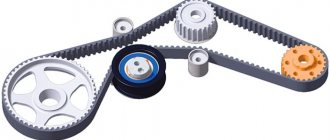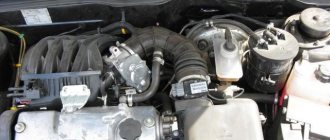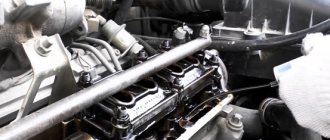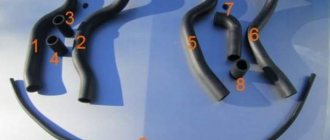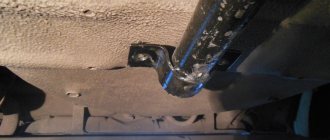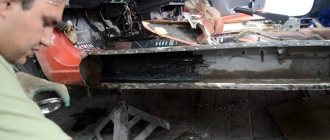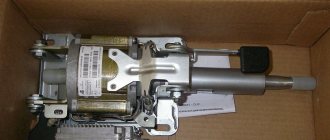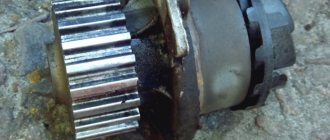Execution Sequence
1. Prepare the car for work (see “Preparing the car for maintenance and repair”).
2. 10 mm
Unscrew the three bolts securing the front timing belt cover.
3. Lift the cover vertically upward and then remove it from the engine.
4. Rotating the crankshaft, we check the condition of the belt by external inspection.
Note: The crankshaft can be rotated with a 17 mm socket wrench (19 mm on some cars) by the bolt securing its pulley or with a large slotted screwdriver by the flywheel teeth. To do this, remove the rubber plug from the hole in the clutch housing (see “Timing Belt - Replacement”).
The belt must be clean - without dirt or oil on its surface. A belt with tears, cracks, delaminations, cut or worn teeth, or abrasions down to the cord must be replaced (see below, “Timing Belt - Replacement”).
5. Using two fingers, we try to rotate the belt 90° in the area between the crankshaft and camshaft pulleys, applying a force of 15-20 Nm (1.5-2.0 kgfm).
If the applied force is not enough to turn the belt to the required angle, then the belt will be overtightened; If the belt can be turned to a greater angle, it is not tensioned enough.
Warning! Belt tension should be adjusted on a cold engine. Excessive belt tension, oil and dirt on it will shorten the service life of the belt, as well as the tension roller bearings and the coolant pump. If the belt tension is weak, it may jump over several teeth of the camshaft pulley.
6. To check the relative position of the camshaft and crankshaft, set the piston of the first cylinder to TDC of the compression stroke. For this:
A. Remove the rubber plug installed in the upper part of the clutch housing.
b. Through the resulting window, use a slotted screwdriver with a wide blade to turn the crankshaft by the teeth of the flywheel ring.
. until the mark on the camshaft pulley and the protrusion of the rear timing belt cover align.
In this case, the mark on the flywheel should align with the center of the scale.
Recommendations: If the relative position of the crankshaft and camshaft is disturbed, then turn the crankshaft until the mark aligns with the center of the scale. Loosen the belt tension and remove it from the camshaft pulley. Turn the camshaft until the mark on its pulley aligns with the protrusion on the rear cover. Without changing the relative position of the shafts, put the belt on the camshaft pulley and adjust the belt tension.
7. 17 mm
loosen the tension roller nut.
8. By turning the roller with a special wrench, we adjust the belt tension and, holding the roller in this position, tighten the nut that secures it.
9. Check the belt tension (see above) and, if necessary, repeat the adjustment.
10. Finally tighten the roller fastening nut to a torque of 33.2-41.2 Nm (3.4-4.2 kgfm).
11. Reinstall the front belt cover and tighten its fastening bolts.
Timing belt tension method
Hello, dear visitors of Drive! The other day I noticed that the timing belt started clicking. I immediately went into the garage and removed the top half of my sawed-off drive cover. Indeed, the belt turned out to be very loose. Inspection showed that the tension roller had moved.
The fact is that during the previous adjustment of the belt tension, the pin began to rotate along with the roller nut. Having read horror stories about the fragility of the stud, I decided not to touch it, and, having adjusted the tension, I was afraid to tighten the nut too much. I clearly tightened it weakly, and this is the result. It's good that the belt teeth didn't jump. I realized that it is undesirable to touch this unit again, and in order not to unnecessarily rotate the nut, and with it the stud, I need a reliable way to check and adjust the tension. The method proposed in many manuals for checking belt tension by twisting it 90 degrees with a force of 2 kgf does not provide for measuring this force. It is very difficult to evaluate it subjectively. As a result, the belt is either loose and slams, threatening to jump, or it is overtightened and howls like a shot down Messerschmitt in Soviet films.
I remembered that I read somewhere a long time ago that you can tighten the belt with a household dynamometer using a special key. I bought a key on the market for 50 rubles, but it turned out to be impossible to work with it. I had to bend it into an “G” shape, screw the sector in place and make recesses for the dynamometer hook. The length of the arm from the key pins to the point of application of the torque force is 80 mm.
And then everything is simple. We put the x17 key on the driven gear nut and, lightly tapping it with your hand, select the slack in the drive belt branch. Next, we insert a special key into the holes of the roller axis, engage the key rod with a dynamometer and create a force of 2.5...3.0 kgf. Holding the special wrench by the sector, tighten the roller nut. The main thing here is not to overdo it and not tighten the nut with a torque of more than 4.2 kgcm, otherwise the stud may bend and the belt will subsequently slip.
Source
VAZ 2115: replacing the timing belt - not everything is so complicated
VAZ 2115 timing belt replacement, belt operation diagram
Replacing the timing belt on a VAZ 2115 is a standard procedure that is included in maintenance; replacement should be done every 50,000 kilometers or once every 3 years of operation of the car. If the belt breaks during operation, then you should put on a new one and first determine the degree of damage to the gas distribution mechanisms (check the compression, if not, check the valves, then the condition of the pistons, and so on). To avoid problems, it is better to replace the VAZ 2115 timing belt according to the regulations, regardless of its external condition.
Which timing belt is better to choose for VAZ 2114 8 valves
The material used to manufacture modern timing belts is dense metal rubber. The reliability, wear resistance and service life of the product directly depend on its quality. If it is necessary to replace it, the car owner is faced with a difficult question: which belt to choose, which manufacturer and brand to give preference to.
The situation is complicated by the presence of a large number of counterfeits of well-known brands on the market. Due to high-quality imitation of appearance, including packaging, inscriptions, holograms, it is almost impossible to distinguish them from original products.
For example, some manufacturers, such as Gates, increase the service life of belts by increasing the resistance of materials to significant temperature changes, exposure to technical fluids, and oil.
This happens due to the use of nitrile instead of neoprion. Unscrupulous manufacturers use simpler and cheaper materials.
If you buy an outwardly identical fake, you may end up with premature failure of the belt, roller, pump, and be undeservedly disappointed in the brand.
To avoid such a risk, it is better to buy from official services and trusted suppliers.
According to test results, belts from domestic manufacturers perform no worse than foreign ones, for example BRT. Given the affordable price, this is a big plus.
Imported ones - Contitech and Lemforder - have good quality. Slightly more expensive and stronger than Dayco. Also Roulunds and Bosch, but much more expensive..
Purpose
It is important to note that such 8-valve engines were installed on all (almost) VAZ models, so this manual is relevant for cars with such an engine, if you have a 16-valve engine, then look, replacing the timing belt on a VAZ 21154 is described a little lower . So:
- The timing belt is the most important element of the gas distribution mechanism; it is responsible for the timely injection of the fuel-air mixture and the emission of exhaust gases
- Its breakage is dangerous, since damage to the valves and even pistons is possible, after which a major overhaul may be required with the replacement of the piston group or the cylinder head - the price of inattention
- It is a rubber-metal belt with teeth on the inside; the teeth firmly engage the camshaft and crankshaft gears to ensure their synchronous operation.
When is replacement necessary and what is needed for this?
During the depreciation period, the timing belt begins to peel, tear or slip. If a breakdown occurs while the engine is running, it stalls and becomes impossible to start. When operating a VAZ 2114 with an engine equipped with an injection device for supplying fuel, an indicator on the instrument panel will light up, notifying you of a phase sensor error.
If the car is equipped with a 1.5 liter, 8-valve power unit, then the repair itself will only require the purchase and replacement of a belt. If a 1.3 liter engine is installed, this breakdown will lead to damage to the entire gas distribution mechanism. Major renovations will be needed. The timing belt replacement on a VAZ should take place after 45 thousand km of vehicle operation. Constant monitoring of the mechanism is necessary for the purpose of prevention. The sequence of actions is as follows.
- Purchase and replace the tension roller.
- Eliminate possible play in the pump.
- Lubricate the roller mechanism.
https://youtube.com/watch?v=OT_YOtxXIoM
If you have simple plumbing tools, replacing the timing belt is possible at home. List of tools needed to repair the unit in question.
- Wrenches in sizes 10, 13, 17,19;
- Socket wrench with pipe.
Let's move on to replacement
When replacing, the tension roller must also be changed (in addition, it is recommended to replace the cooling pump every second belt replacement). Operating procedure:
- Stop the car with the handbrake, then place chocks under the rear wheels.
- Raise the front right side with a jack and unscrew the wheel.
- Remove the wheel and protective mudguard
- Using the “10” key, unscrew and remove the timing case
Removing the timing cover
- To remove the generator pulley bolt (you can lock the flywheel by inserting a screwdriver or pry bar through the inspection window on the gearbox housing)
- Remove the alternator belt, then the pulley
- Unscrew and remove the timing belt protective cover
- Align the engine according to the marks (one is located on the camshaft, and the second is on the flywheel)
About the procedure for doing the replacement yourself
Open the engine compartment hood and disconnect the terminals on the battery. Further work is carried out in this order:
- Using a “10” key, unscrew the screws securing the plastic cover of the front part of the timing mechanism and remove it from the engine.
To loosen the tension of the generator set drive, take the key to “13”, loosen the tension, and dismantle the generator belt.
Now you need to set the control marks in the drive. To do this, the assistant uses improvised means to rotate the crankshaft pulley, and the driver controls the location of the installation marks. One of them is on the camshaft pulley and the cover behind the pulley, the second is on the cylinder block and the crankshaft pulley.
To ensure that the marks are installed correctly, remove the rubber plug on the clutch housing. In the window that appears, a mark on the engine flywheel should be visible, which coincides with the mark on the clutch housing.
- The time has come to remove the engine crankshaft pulley. It is necessary to stop it from turning. To do this, engage first gear and press the brake pedal. After this, use a socket wrench to “17” to unscrew the pulley mounting bolt and remove it from the engine.
- To remove a worn belt, you need to loosen its tension. This is done by unscrewing the tensioner roller fastening bolt, then turning the roller to the left and dismantling the belt.
- When it is planned to replace the tension roller and cooling system pumps, they are removed from the engine. Before this, the engine cooling system fluid is drained.
16 valve engine
On sixteen valve engines, in contrast to eight valve engines, when the timing belt breaks, serious consequences occur:
- Since a break or a belt slipping through a tooth (or several teeth) is almost one hundred percent likely to occur in pistons with valves
- This definitely leads to bending of the latter, and therefore major repairs are not very cheap
- That is why the instructions require checking the condition of the timing belt drive and replacing it in a timely manner.
- You should not forget about the quality of domestic spare parts, so you should take this issue seriously
- It is prescribed to check the condition of the belt every 15 thousand kilometers and replace it after 50 thousand or earlier, follow these rules
Diagram of the gas distribution of a 16-valve engine
- To visually assess the condition of the belt, pry off the plug with a screwdriver, it is located on the front drive cover
Removal
Replacing the VAZ 21154 timing belt begins with removing it, for this:
- Stop the car and put chocks under the rear wheels
- Using the “10” head, unscrew the six bolts that secure the front cover and remove it
Removing the timing mechanism casing
- Then remove the right wheel and behind it the plastic shield covering the engine compartment
- Using the “17” head, turn the crankshaft in a clockwise direction using the bolt that secures the generator drive pulley
- In the flesh until the marks on the camshaft pulleys coincide with the marks on the rear timing case cover
- On the engine flywheel, the mark should be opposite the mark on the slot in the clutch cover cover
- Insert a screwdriver through the hole located on the clutch housing between the flywheel teeth to fix it, unscrew the generator drive pulley bolt
- Remove the pulley
- Then use a 17" wrench to loosen the tensioner pulley nut.
Use a wrench to loosen the drive tension by loosening the tensioner roller nut
- Turn the roller and loosen the belt tension, remove its rear branch, starting with the toothed pulley on the exhaust camshaft, then with the tension roller, then with the pump pulley
- After this, the belt is removed from the crankshaft and exhaust camshaft pulleys and from the support roller
- The drive belt is installed in the same way, the sequence of putting it on is the reverse of taking it off.
- We make sure that the alignment marks of the shafts match
- By turning the tensioner roller, tighten the drive belt and fix the roller
- After this, rotate the crankshaft two revolutions and check again that the alignment marks match
- Replacement of VAZ 21154 timing belt drive is completed
- The tension is checked by pressing your fingers in the middle part between the camshaft pulleys
That's all, no matter what type of engine you have, our article is useful in both cases, take care of the car, in addition to these procedures, follow the others prescribed in the manual, and additionally watch our video.
Timing belt 2108.10 - 8kl (slips and wears off, after tension there is extraneous noise)
Many have encountered such a problem as the belt slipping and being “eaten”. Sometimes such a car is bought second-hand, or during scheduled maintenance when replacing a belt, rollers, or pump, this happens.
Also, all this is overgrown with numerous myths: like the tension roller pin is bent, the timing gear is worn out - well, to manage to bend the M10 pin, of course you need to try (!); wearing out the timing gear with a rubber belt is probably(!) only possible in a million kilometers, but not in 100,200 or even 400 thousand km.
Let's figure out why this happens.
Belt slippage occurs:
1. poor-quality belt
(after replacement, it moves outward/inward) - you can determine by turning the belt over to the other side
2. Pump
- misalignment and, as a result, the belt moves out (if the pump is worn out or when installing a new pump, the mating surface to the block was poorly cleaned of the old one gaskets, sand, dirt)
3. The tension roller wears out the bearing
and, as a result, the roller is skewed.
4. banal tugging of the belt!
A very common case - you may not even notice it. In the case of operations with the timing belt, when the belt begins to slip (and before that everything was fine), check the belt tension, barely tighten it and look - if it doesn’t slip, it means the belt was tightened too much!
When changing the pump and rollers, you need to thoroughly clean the mating surface on the block and on the mating mechanism (roller/pump); there should be no sand or dirt, otherwise there will be distortion.
Sometimes everything is simpler than it seems!
By the way, I can’t understand who came up with the story about the fact that timing gears need to be changed...even the factory doesn’t regulate their replacement - they are eternal; a rubber belt in life will not erase an iron gear; 9 cars from the 80s to this day have the original gears and nothing has worn off and it works with a bang (and they have mileage even under 400 thousand) - most likely this story came from crooked services where they usually change everything just to squeeze more money out of the client...
You do not need to tighten the belt too much so that its part from the timing gear to the crankshaft can be rotated 90 degrees with a little finger effort, but does not dangle. If you tighten the belt a little, the pump will start howling. You need to grasp this fine line.
By the way, there are those who pull the roller in the other direction - i.e. clockwise is not correct! Tension only counterclockwise!
All this information posted by me is based only on personal experience, trial and error + consultations with competent people. Miracles don't happen; if the mechanism doesn't work, then you made a mistake.
Naturally, all this is provided that your crankshaft/camshaft is not hanging out in bed!
Source
How to replace timing rollers on a VAZ 2115 with your own hands?
Many motorists do not pay enough attention to the condition of the timing components, or are not at all aware of the existence of such a system. But in vain, even the slightest malfunction of any component can eventually result in a serious breakdown, sometimes even with catastrophic consequences. In this article we will talk about the main causes of malfunctions and how to avoid them. In addition, we will show you how to change the rollers and timing belt on a VAZ 2115 yourself.
Timing roller location
Before you begin diagnosing or replacing the timing belt and rollers on a VAZ 2115 with 8 valves, you need to determine where the system itself is located. You can find it on the left side of the engine if you stand in front of the hood. It is located under a protective cover that prevents debris and dust from entering the system. For visual diagnostics, simply unscrew a couple of bolts and remove the upper part of the casing. However, if you are planning a more serious operation, such as replacing a belt or rollers, this will not be enough.
Causes of breakdowns
Most failures of rollers, belts and other components of the gas distribution system are in one way or another related to improper belt tension. An overtightened belt can lead to wear on the bracket, the surface of the pulleys and the bearings in the rollers. In turn, if the tension is insufficient, the belt begins to slip over the rollers and gears, its teeth break off and fall under the belt itself, leaving dents on the rollers. That is why during installation, set the correct belt tension. Under no circumstances should it be installed on a hot or even warm engine. Because as soon as the engine cools down, the belt will begin to sag. To check the tension, you will need a spring scale and a caliper. We grab the scale by the section of the belt between the crankshaft gears and pull it down to the ten kilogram mark. Then, using a caliper, we measure the deviation from the normal position. If the deviation is 5-5.5 millimeters, you have set the belt tension correctly.
In addition, among the common malfunctions are fuel or oil leaks. During a leak, liquid gets onto the belt and begins to corrode it. This can be determined by the pieces of rubber and synthetic threads stuck around the rollers. Another common cause of breakdowns is the entry of debris and foreign bodies into the system. This can be determined by cracks and potholes on the working surface of the roller, caused by debris getting under the belt. Do not forget about malfunctions caused by system overheating.
Procedure for replacing timing rollers
Before replacing, you first need to install the car on a viewing hole or lift and let the engine cool for two to three hours. If you perform a hot replacement, you risk serious burns. Before the replacement itself, you need to remove the key from the ignition switch and disconnect the negative contact of the battery pack.
You will need the following tools:
- 10mm socket and ratchet;
- Open-end wrenches for 13 and 17;
- Flat head screwdriver;
- Tensioner pulley wrench;
- Jack;
- Cross key.
The procedure for replacing rollers and timing belt on a VAZ 2115 is as follows:
- We dismantle the protective casing of the gas distributor;
- Remove the belt tensioner for the attachments;
- We put the car in neutral and jack up the right front wheel;
- We rotate the car wheel until the mark on the camshaft gear matches the mark on the belt cover;
- We align the flywheel so that the mark on it aligns with the triangle on the body. To do this, loosen the tension roller and turn it counterclockwise;
- We fix the flywheel in the desired position by inserting a screwdriver between its teeth;
- We dismantle the front right wheel, after which we dismantle the protective arches;
- Unscrew the fixing nut of the generator gear. When carrying out this procedure, make sure that the flywheel has not moved from the desired position;
- Remove the generator pulley;
- Loosen the belt tension and remove it. If replacement is necessary, we dismantle the roller itself;
- We unscrew the parasitic gas distributor roller and change it;
- We mount the pulleys and gears in place and pull the timing belt onto them. Make sure that the crankshaft and flywheel alignment marks are not off;
- We tighten the timing belt. To do this, we rotate the tension roller counterclockwise using a special key.
We carry out further assembly in reverse order. When assembling, make sure that you do not knock down the inserted marks.
Belt replacement
Required tools:
- socket wrench 10 or similar size ratchet head;
- open-end wrench 13;
- open-end wrench 17;
- slotted screwdriver (large);
- special tension wrench for the tensioner pulley;
- jack, wheel wrench;
- a little machine oil.
First you need to set the timing gear and engine flywheel in accordance with the existing marks.
1. Place the car on a level surface and engage any gear.
2.Use a jack to lift the front right wheel so that it can rotate.
3.Open the hood, use a 10mm wrench to unscrew the 3 bolts securing the timing belt protective cover.
4.Using a 13 key, loosen the generator belt tensioner and remove it.
5. On the camshaft gear we find a mark in the form of a rectangular protrusion on the edge. It should align with the protrusion on the belt cover mount.
6.If it doesn’t match, put the car in gear and turn the right wheel until the marks match.
7.After this, we find a rubber plug on top of the clutch housing. It is located to the right of the cylinder block. Pry it off with a screwdriver and take it out. Below it is the flywheel crown, which also has a mark that should coincide with the triangular protrusion on the left.
8.If there is no such coincidence, use a 17 wrench to loosen the fastening of the tension roller, and using a tension wrench, turn the roller counterclockwise, loosening the belt.
9. Having removed the upper part of the timing belt from the timing gear, use a 17 mm spanner to turn the crankshaft until the flywheel marks coincide.
10.Fix the flywheel in this position by inserting a screwdriver between its teeth. It’s great if you have an assistant who will additionally hold it.
11. Dismantle the front right wheel, remove the arch protection.
We recommend: Do-it-yourself replacement of the front door window regulator of VAZ 2101, 2106
12.Using a 17 wrench, unscrew the nut securing the generator pulley, making sure that the flywheel does not rotate.
13.Remove the generator pulley and take it out.
14.Now the timing belt can be removed from the crankshaft pulley.
15.Using a 17 wrench, completely unscrew the tension roller fastening and remove it; you can simply loosen it and the belt will come out.
16. Without disturbing the position of the marks, put a new belt on the crankshaft pulley, install the generator drive pulley in place, having first put the belt on it.
17. We put the belt on the timing gear.
18.Install a new tensioner roller, lubricating it on both sides with machine oil (if removed).
19. We tighten the belt by rotating the tension roller with a special wrench (if you don’t have one on hand, you can insert two pins or screws into the grooves and secure them with a screwdriver) counterclockwise. The tension at which one plane of the belt can be rotated 90 degrees horizontally using your fingers is considered normal. In this position, tighten the tension roller mounting bolt.
20. We carry out further installation in the reverse order; if your marks are lost, then you definitely need to set them again.
Timing and frequency
According to the regulations for carrying out technical work, on the VAZ 2114 the procedure for replacing the timing belt and rollers should be carried out every 120 thousand kilometers. However, in reality this deadline usually comes earlier. Many car enthusiasts advise preparing for replacement after 90 thousand kilometers. Do not forget about regular inspection of the components of the gas distribution system. If you notice the slightest problem, the defective components should be replaced immediately. Failure to promptly replace faulty parasitic rollers will sooner or later lead to a broken timing belt. During a break, desynchronization of the valves and piston occurs, which leads to breakdowns and deformation of these components.
VAZ 2115 and VAZ 2114: differences in replacing timing rollers
The design of the timing system is identical on all cars of the Lada Samara family. This applies to both models of the first (VAZ 2108 - VAZ 21099) and second generation (VAZ 2113 - VAZ 2115). The only relevant difference is the width of the crankshaft pulley and the timing belt itself. On second generation models, they are much narrower than on older ones. Because of this, separated timing parts are not interchangeable for different generations of cars. Therefore, before purchasing parts, make sure that they will fit your specific car model.
How to properly tension the timing belt on 8 and 16 valve VAZ cars
Correctly tensioning the timing belt on production vehicles is a simple procedure, but it requires certain special knowledge.
The algorithm of actions may vary slightly depending on the model of the power unit, and not on the make of the car. There are differences in the procedure for replacing and tensioning the belt on 8-valve and 16-valve engines. Read on to find out how to tighten the timing belt on both types of car hearts.
Four-cylinder eight-valve power units are more often found on:
Sixteen-valve engines are mainly used:
- On VAZ-2112;
- Lada Priora;
- Lada Kalina;
- Lada Largus;
- Lada Granta;
- Lada news.
A number of cars of the Samara 2 family were also equipped with 16-valve engines. In addition, such engines were also installed on models 2110-2111.
Ignition system sensors and marks
For the ignition system to operate correctly, the computer needs to read the correct information from the sensors. Subsequently, this information will be processed in accordance with the fuel maps hardwired into the injector.
The main signal comes from the crankshaft sensor. This sensor shows what position the crankshaft is in at a given time and, based on it, calculates at what moment it is necessary to inject fuel, and at what moment this same fuel should be ignited, depending on the engine speed, which is also determined by this sensor.
1 – crankshaft drive disc; 2 – crankshaft position sensor; 3 – angle of rotation of the crankshaft; 4 – output signal of the crankshaft position sensor And this is what a typical signal received by the computer from the crankshaft sensor looks like
Pay attention to 270° - this is like the zero point, showing the computer that the engine has completed a revolution and a new cycle begins. This is achieved due to the absence of a tooth on the crankshaft drive sprocket.
When to tension the timing belt
The timing belt of the VAZ-2112 and other VAZ models is tensioned in the following cases:
- Installing a new belt;
- Loose belt;
- “Slipping” of the belt with a violation of the timing adjustment;
- Replacement of the tension roller and other timing drive mechanisms.
If the cause of the intervention is a broken or “slipping” belt, you must first ensure the integrity of the valves. A broken gas distribution mechanism (drive) leads to engine damage on 16-valve 1.5-liter power units. However, in cases of drive failure at high speeds, valves and CPGs are also destroyed on other engines.
They check the operation of the timing belt on the VAZ-2114 and other models equipped with 8-valve units by turning the camshaft manually. A working mechanism should turn with some effort. A faulty one, as a rule, cannot be affected.
During the procedure, it is necessary to check the compression in each of the cylinders. The easiest way to do this is to tightly cover the spark plug hole with paper. If there is pressure in the cylinder, the plug is knocked out of its seat at a certain stage of camshaft rotation. ” alt=””> A similar check on 16-valve engines is not recommended. The risk of damage to an initially good valve mechanism is too great. There are no grooves in the pistons of one and a half liter engines of this type. Therefore, valves that move down bend when they contact the piston surface.
Installing a new belt
Installation of the timing belt VAZ 2113, 2114, 2115 8 valves is carried out in the reverse order of removing the worn part. Before starting work, carefully check the position of the timing marks in the timing mechanism drive again. Failure to perform this check may damage valve train components in the cylinder head. There are known cases where, in addition to valves, pistons and, in some cases, connecting rods were damaged. Install the adjusting washer first, then the tensioner roller, screw the nut onto the bolt securing it, but do not tighten it. When the engine cooling system pump is changed, a new spare part is installed. Next, the order of work will be as follows:
Belt tension on 8-valve VAZ engines
Before tightening the timing belt on the VAZ, the following preparatory work should be performed:
- Hang up and remove the right front wheel;
- Unscrew the 3 bolts securing the front timing cover;
- Remove the cover;
- Use a 17 key to loosen the tension roller.
After this, you should check the drive marks. One of them, located on the crankshaft pulley, must coincide with the installation tab of the rear cover. At the same time, check the mark on the flywheel. It should be flush with the alignment mark on the block boss.
IMPORTANT! In reality, it is not always possible to achieve an exact match of marks. Therefore, the mechanism is adjusted with an error of +/- 1-2 mm. This does not have a noticeable effect on the driving performance of the car.
If the marks match, the question of how to tighten the timing belt can be considered resolved. Without removing the belt, it is necessary to move the weakened tension roller to the right so that the necessary tension occurs. After this, the roller is tightened tightly. To adjust the roller, a special “horned” key is used. If it is not available, you can use two Phillips screwdrivers, which are inserted into special holes on the roller.
If the marks do not match, the timing belt on the VAZ-2109 must be removed from the pulleys. After this, the pulleys themselves are individually set according to the marks. It is better to start reinstalling the belt from the rear branch. After installing it, the roller is tightened.
IMPORTANT! When installing the timing belt on a VAZ-2114 and other front-wheel drive models, the pulleys located according to the marks can shift by 1-2 teeth. If this happens, the marks should be set with an error to the left, which allows you to compensate for the offset. After installing the belt, the pulleys themselves will move into the required position.
It is necessary to finish tensioning and fixing the belt, and then manually turn the engine 2-3 turns by the crankshaft pulley. To do this, it is convenient to use a “19” head with an extension. The gearbox must be in neutral. If after turning the marks have not moved relative to each other, the procedure can be considered completed. Assembly is carried out in reverse order. ” alt=””> The question of how to check the consistency of the tension should be answered. To do this, hold the strap between your thumb and index finger and turn it 90°. The technician must be able to do this, otherwise the belt is considered over-tensioned.
Timing belt tension VAZ 2110, 2111 (8 cl.)
To adjust the belt tension, turn the crankshaft counterclockwise so that the mark on the camshaft pulley moves down from the rear cover antenna by two teeth.
| The timing belt is a rubber belt, with notches on the inside, designed to synchronize the crankshaft and camshaft of the engine. It is important that it is not only installed correctly, but also tensioned. Do you know how to properly tension the timing belt with your own hands? |
Checking the timing belt tension means that the front branch of the belt is twisted 90° with the thumb and forefinger of the hand with a slight force of 15–20 N (1.5–2.0 kgf). Here questions arise: how to calculate the force? Everyone’s finger strength is different, how do you determine the required strength? You need to tension the timing belt so that in the longest section you try to turn it 90 degrees with 2 fingers, and if this is almost possible, then the belt is tensioned normally.
Try tightening the timing belt and keep in mind that
Belt tension on 16-valve VAZ engines
Tensioning the timing belt on Priora and other cars equipped with 16-valve engines is generally done in the same way.
However, there are slight differences. Thus, the gas distribution mechanism cover of these engines is mounted on 6, and not on 3 bolts, as in the previous case.
In addition, the timing belt on VAZ-2112 power units (16 valves) is tensioned using two rollers. One of them is movable, used for tension. The second one is the support one. ” alt=””> When tensioning the belt of a “Prior” motor or motor 2112, special care must be taken. After putting it on and tightening it, you must definitely try to crank the engine by hand.
If the crankshaft cannot be turned, you should once again check that the marks are installed correctly. On these engines, an error almost always leads to damage to the valves and piston group.
